Knowing just when to plant pansies can really set the stage for endless cool-weather-loving blooms all throughout your property!
Pansies provide growers with bright, welcoming colors in the cooler spring and fall seasons. They are often planted among other early spring flowers like crocuses, tulips, and sweet alyssum and are great when paired with mums and asters for fall displays.
Some pansy varieties are cold hardy and can survive a frost or even single-digit temperatures for short periods. If these fall-planted flowers get zapped by the winter weather, they will often bounce back and bloom again the following spring, allowing you to get the most bang for your buck.
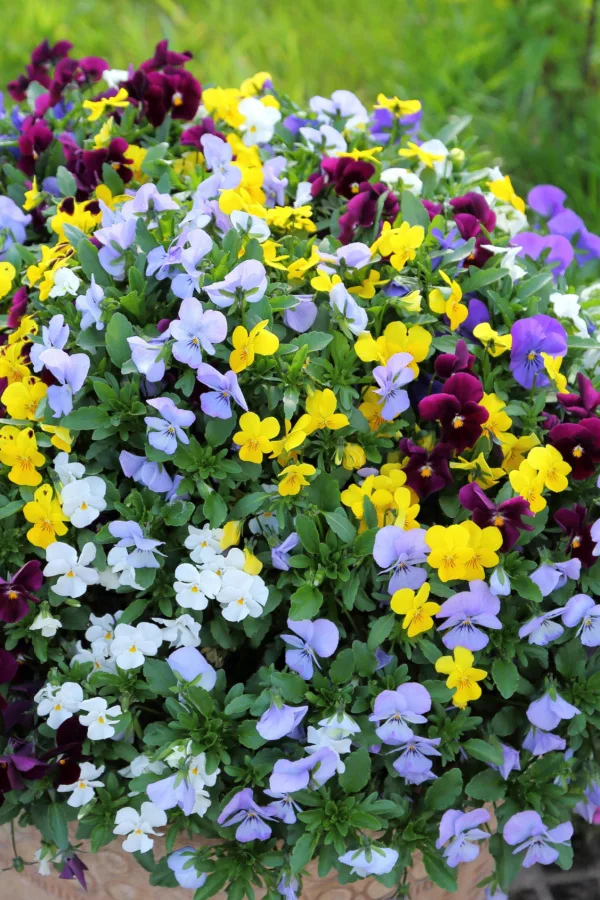
Thankfully, pansies are super easy to grow in both early spring and early fall. In addition, their colorful flowers are edible, too! Their blooms can add texture and color to salads, cookies, sandwiches, drinks, and even cakes.
Pansies are perfect for growing in flower beds and along walkways or fence lines, but they can also thrive in flower boxes and containers as well. With all of their varieties and ease of growing, it’s definitely worth looking into planting them on your property this year!
Varieties of Pansies – When To Plant Pansies
Pansies are from the genus, Viola. They feature wide-shaped petals that overlap around a small yellow center. You can find varieties like that Swiss Giants Ullswater and Swiss Giants Rhinegold which grow in tight and compact spaces. There are also semi-trailing varieties like Cool Wave Mix that look stunning cascading down hanging baskets and window boxes.
One of the best parts of pansies is that their blooms are available in a multitude of different colors and shades. From blue, purple, red, orange, yellow, pink, and white, pansies create a “happy welcoming face” that appears in cooler weather when most other flowers aren’t ready for blooming yet.
Pansies are hardy in growing zones 3 through 6 and go dormant in the colder winter months. In milder zones 7-10, pansies can often bloom throughout winter with their milder temperatures. However, while pansies are actually perennials, they are very short lived and are often treated as annuals in most locations.
When & How To Plant Pansies
Pansies can be either grown from seed or you can purchase transplants from local garden centers.
Choose a growing location that features about six hours of early morning sunlight during the day with a bit of shade protection during the hot afternoon sun. Excess heat and sunlight can cause a reduction in flower production and blooming.
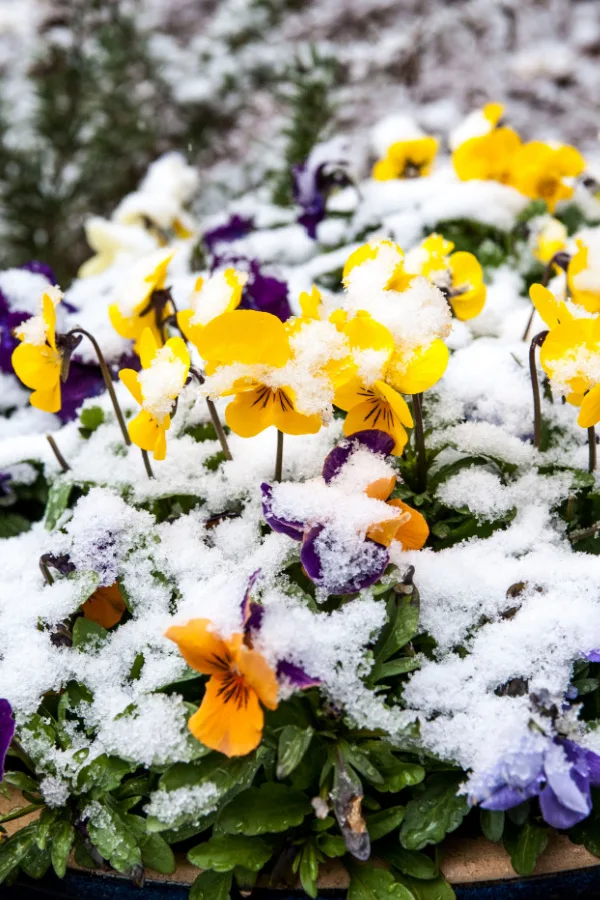
With proper care and maintenance, pansy plants can grow to be around six to 12 inches tall and wide. These measurements will vary some based on the variety of pansies you are growing.
Soil Requirements for Pansies
In order for pansies to have success growing, you need to know when to plant them. The timing really boils down to the soil and outside air temperatures. The soil needs to be around 45 to 65º Fahrenheit (7 to 18º Celcius). Aim for daytime temperatures in the 60s and nighttime temperatures above 40º Fahrenheit.
Pansies grow best in soil that is rich in organic matter with acidic to neutral pH values. Be sure to amend your soil with plenty of compost prior to planting. The compost will not only add organic matter to the soil but also give the plants a head start on growing with all those added nutrients and minerals.
Ensure that soil is well draining and doesn’t have standing water after rains. Any commercial potting mix should be sufficient for potted pansies, but consider adding worm castings and a handful of compost to the potting mix prior to planting.
Starting Seeds Indoors – When & How To Plant Pansies
While it is possible to start pansy seeds indoors, you will likely have a bit better luck with transplants. However, if you want to use seeds for spring blooms, aim for starting seeds around eight to ten weeks before your last spring frost date. For fall blooms, start seeds about eight to ten weeks before your first fall frost date.
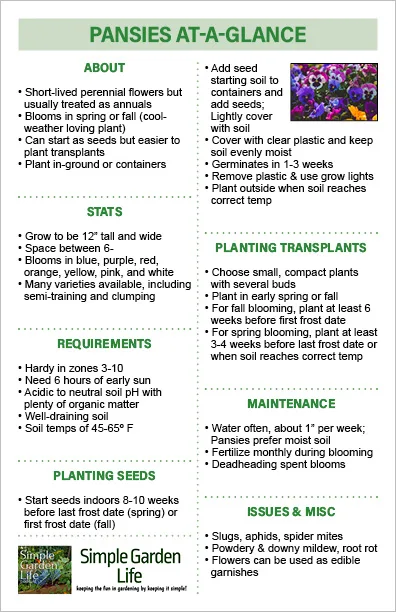
Fill any container of your choice that has drainage holes with seed-starting soil. Place a few seeds in the containers and lightly cover them with additional soil. Cover the container with a clear plastic lid or even plastic wrap and keep the soil evenly moist.
Seeds might take anywhere between one to three weeks before germinating. Once germination occurs, remove the plastic lid and place trays under your “grow” lights. Keep the lights a few inches above the seedlings, raising them as needed.
Before planting your seedlings into the soil outside, be sure to harden off the plants. Plant spring transplants when the soil temperatures reach ideal temperatures. Get fall-blooming transplants in the ground at least six weeks before your first expected frost to allow plants to become established.
Planting Transplants – When & How To Plant Pansies
When choosing transplants, be sure to choose small and compact plants that have multiple buds. Pass on plants that are already blooming and those that are tall and leggy. Also, avoid plants that are overly root bound.
Pansies can be planted either in the early spring or early fall. Avoid planting during the heat of summer since plants just aren’t meant for warmth. Many gardeners actually prefer to pull spring-planted pansies after they are done blooming to make room for their summer-blooming flowers.
If you plant pansies too late in the fall or too early in the spring before soil temperatures are right, the roots won’t be able to grow properly and plants will end up stunted. For fall planting, try to get plants in the ground at least six weeks before your first frost date. For spring planting, get transplants in the ground about three to four weeks before your last frost date or whenever the soil reaches the right temperatures.
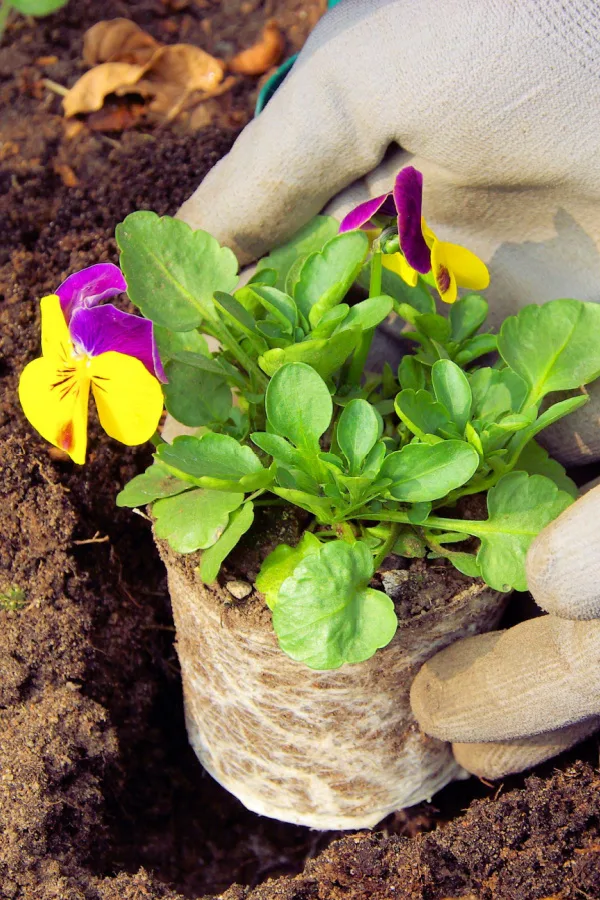
The spacing you use for each pansy plant will depend on the variety you are growing. You can space compact varieties around six to ten inches apart to create a beautiful spread of blooms and color. You can also stagger rows to create a tidier, cleaner look if you prefer.
Dig a hole that is slightly larger than the plant’s root ball. Mix in a few inches of compost or worm castings if needed and place your pansy inside. Backfill with additional soil and lightly tamp down around the plant. Water well to help settle the soil.
Long-Term Care – How To Grow and Maintain Pansies
Watering
Pansies prefer to have fairly moist but not overly saturated soil. Aim for watering around an inch every week or whenever the soil is dry. Be sure to consider rainfall amounts as well. Try not to water pansies in the evening and avoid watering overhead whenever possible.
Fertilizing
You don’t need to add any additional fertilizer when planting pansies if you amended the soil with compost. However, you can apply a light dose of all-natural fertilizer every month or so during the active blooming period. Avoid over fertilizing since this can make the flowers leggy.
Deadheading & Pruning
To help promote additional bloom production, you should remove any faded or dead blooms. This will help to prolong the blooming season while also keeping your plants looking healthier and tidier. Simply pinch or snip off faded blooms every couple of days for best results.
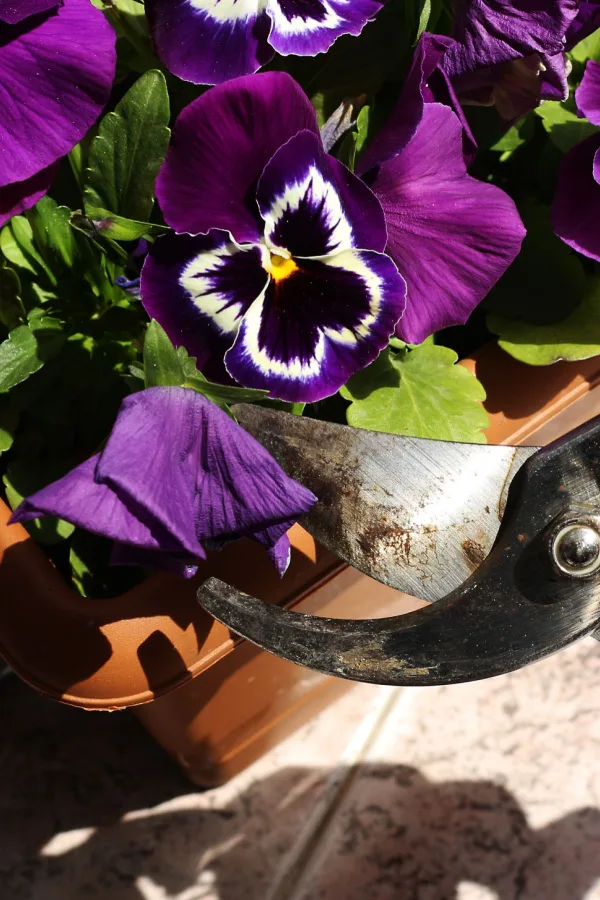
Pests & Issues
There are a few diseases and issues that affect pansies, including powdery and downy mildew. Ensuring proper spacing will help to allow better airflow and help to reduce the chance of both diseases. Pansies can also die from root rot if the soil doesn’t drain properly. If you notice that the plants are starting to turn yellow or are dying suddenly, remove the affected plants and discard them immediately.
Also, be on the lookout for damage from slugs. Other typical pests like aphids and spider mites can also become problematic with pansies as well.
As long as you keep your pansies well watered and protected from warmer temps, you can enjoy their vibrant blooms all throughout the cooler growing seasons!
Follow Our Facebook Page For Even More Great Tips! Simple Garden Life Facebook Page
Simple Garden Life is a website dedicated to keeping gardening fun, simple and enjoyable! We publish two new articles each week along with a new garden podcast episode every two weeks. This article may contain affiliate links.
Feel free to download, print out, or save our Pansies At-A-Glance sheet. It is sized for half-letter printing but can be scaled if needed.
